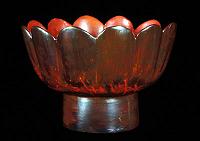Dated 1066 
Lacquer ware
Diameter 14 cm
This ewer, with its globe-shaped belly and high, fluted neck, has an extensive carved floral decoration under a blue-green glaze. Characteristic carvings on productions from the Yaozhou kilns under the early Song were deeply incised on this type of piece as much as 5mm deep producing graceful contrasts between the shaded zones created by the accumulation of glaze at the decorative contours, and the lighter zones covering the reliefs.
The motifs were carved into warmed grey clay using a bamboo knife. The piece was then soaked in a bath of glaze and subsequently fired in the kiln at a temperature of 1250o C. Over time, these glazes, applied in successive layers, thickened and took on an olive-green tone.
It was perhaps because of their contrasting colors and painstaking execution that the phoenix celadons earned their place as items of imperial tableware. Indeed, this particular piece, with its twin phoenix-head spouts, was presumably intended for the palace of the Empresses, of whom the phenix was the symbol.Both the decoration and form used reveal stylistic similarities with gold and silver tableware, the decorative models of which, inherited from the Tang (618-907), were related to metalworking arts in the Near East. Nevertheless, they belong to an evolutionary process that was to liberate ceramic decoration from metalworking influences and to provide it with its own repertoire of forms and motifs. This type of glaze also played a key role under the early Song. Carrying on from the Miseyao, it paved the way in elevating ceramics in the eyes of the social elite, first to the rank of tableware, and subsequently to the status of collection objects on a par with silver, gold, and lacquerware.
Source: Musée Guimet




